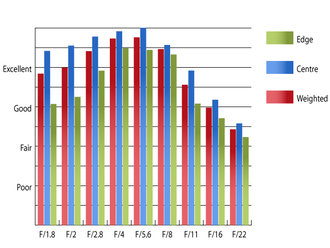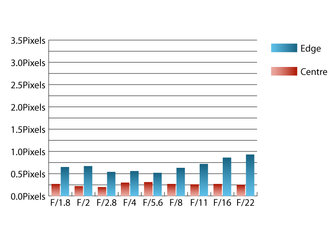Olympus M.Zuiko Digital ED 17mm f/1.8 Lens Review
Olympus M.Zuiko Digital ED 17mm f/1.8 Performance
Sharpness in the centre of the frame is already approaching outstanding levels at maximum aperture, and clarity towards the edges of the frame reaches good levels. Stopping down the aperture improves performance across the frame with peak sharpness being achieved between f/4 and f/5.6, here the clarity recorded is outstanding across the frame.  | How to read our chartsThe blue column represents readings from the centre of the picture frame at the various apertures and the green is from the edges. Averaging them out gives the red weighted column.The scale on the left side is an indication of actual image resolution. The taller the column, the better the lens performance. Simple. For this review, the lens was tested on a Panasonic Lumix G3 using Imatest. |
 | How to read our chartsChromatic aberration is the lens' inability to focus on the sensor or film all colours of visible light at the same point. Severe chromatic aberration gives a noticeable fringing or a halo effect around sharp edges within the picture. It can be cured in software.Apochromatic lenses have special lens elements (aspheric, extra-low dispersion etc) to minimize the problem, hence they usually cost more. For this review, the lens was tested on an Panasonic Lumix G3 using Imatest. |
Chromatic aberrations are on the high side for a lens like this, but remain below one pixel-width in size, so shouldn't pose too many issues, except in areas of extreme contrast towards the edges of the frame.
Falloff of illumination towards the corners of the frame is reasonably well controlled for a lens with a fast f/1.8 maximum aperture. At f/1.8 the corners are 1.58 stops darker than the image centre and visually uniform illumination is achieved with the aperture closed down to f/4.
Unusually, for a wide angle lens, Imatest detected 0.439% pincushion distortion. This level is so low that it should not pose any issues for all but the most demanding applications. If absolutely straight lines are paramount, then you'll be glad to know the the distortion pattern is uniform across the frame. This should make applying corrections in image editing software later a breeze.
Olympus has applied their 'ZERO' anti-refection coating to this lens and it is quite resistant to flare as a result. Bright light sources towards the edges, or just beyond the edge of the frame (the sun, for example) can cause a red haze over affected parts of the image. It would've been nice of Olympus to supply a hood with the lens as standard, even it if will rarely be needed.
Add your message
Login required
Please login here or if you've not registered, you can register here. Registering is safe, quick and free.
Please login here or if you've not registered, you can register here. Registering is safe, quick and free.
photodo Stats
1102 lenses
428 MTF tests
74 in-depth photodo reviews
100+ users join each day
Help the lens community by reviewing or rating a lens today via our lens search
428 MTF tests
74 in-depth photodo reviews
100+ users join each day
Help the lens community by reviewing or rating a lens today via our lens search
Latest Lens Reviews
- Chinon 28mm f/2.8 Vintage Lens Review
- Canon EF 70-200mm f/4L IS II USM Lens Review
- Samyang AF 85mm f/1.4 EF Review
- Sigma 70mm f/2.8 DG Macro Art Review
- Samyang AF 24mm f/2.8 FE Review
- Meike 50mm f/1.7 Review
- Tamron 70-210mm f/4 Di VC USD Review
- Lensbaby Burnside 35mm f/2.8 Review
- Asahi Super Takumar 50mm f/1.4 Review
- Asahi Super-Multi-Coated Takumar 135mm f/3.5 Review
